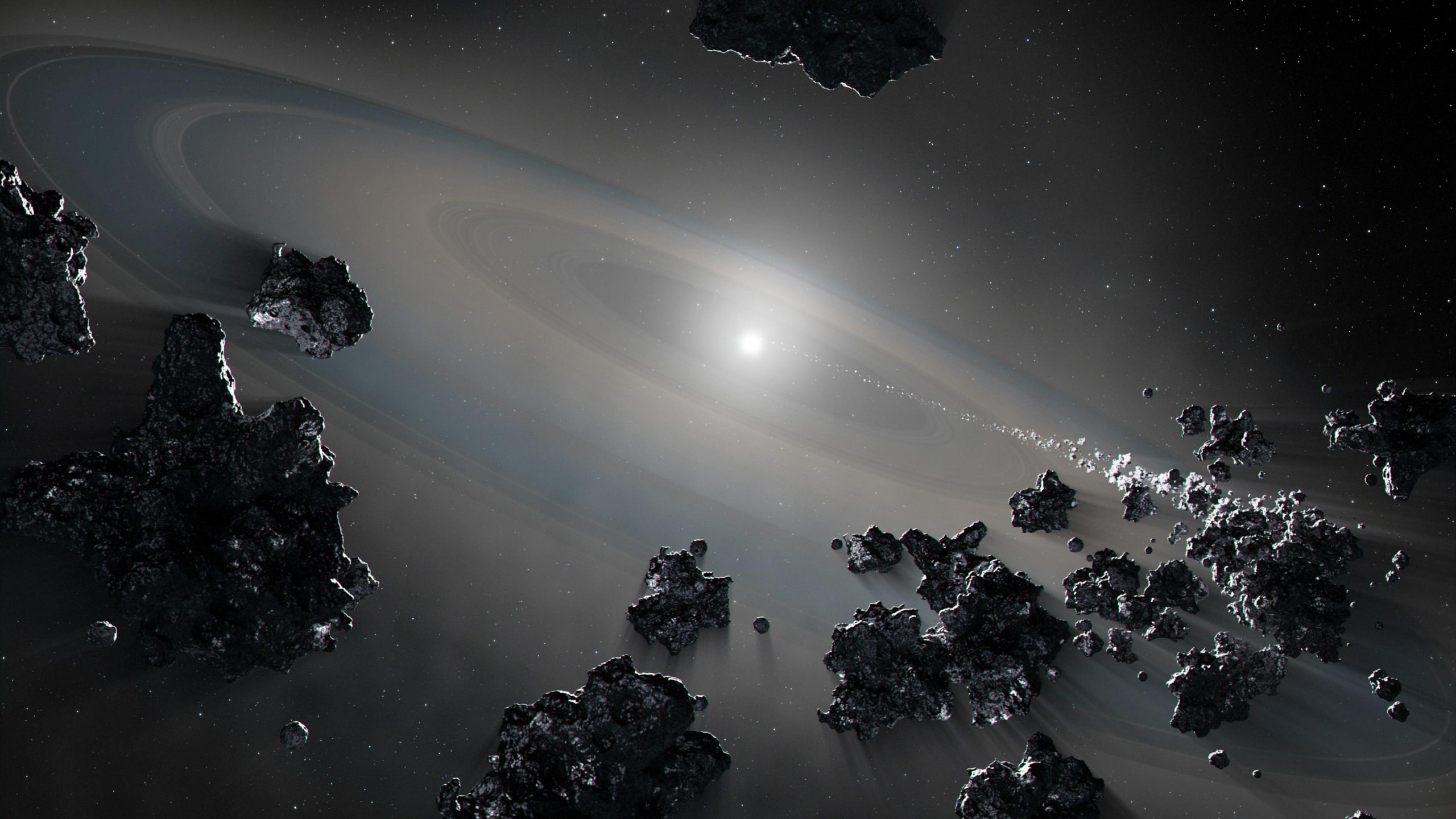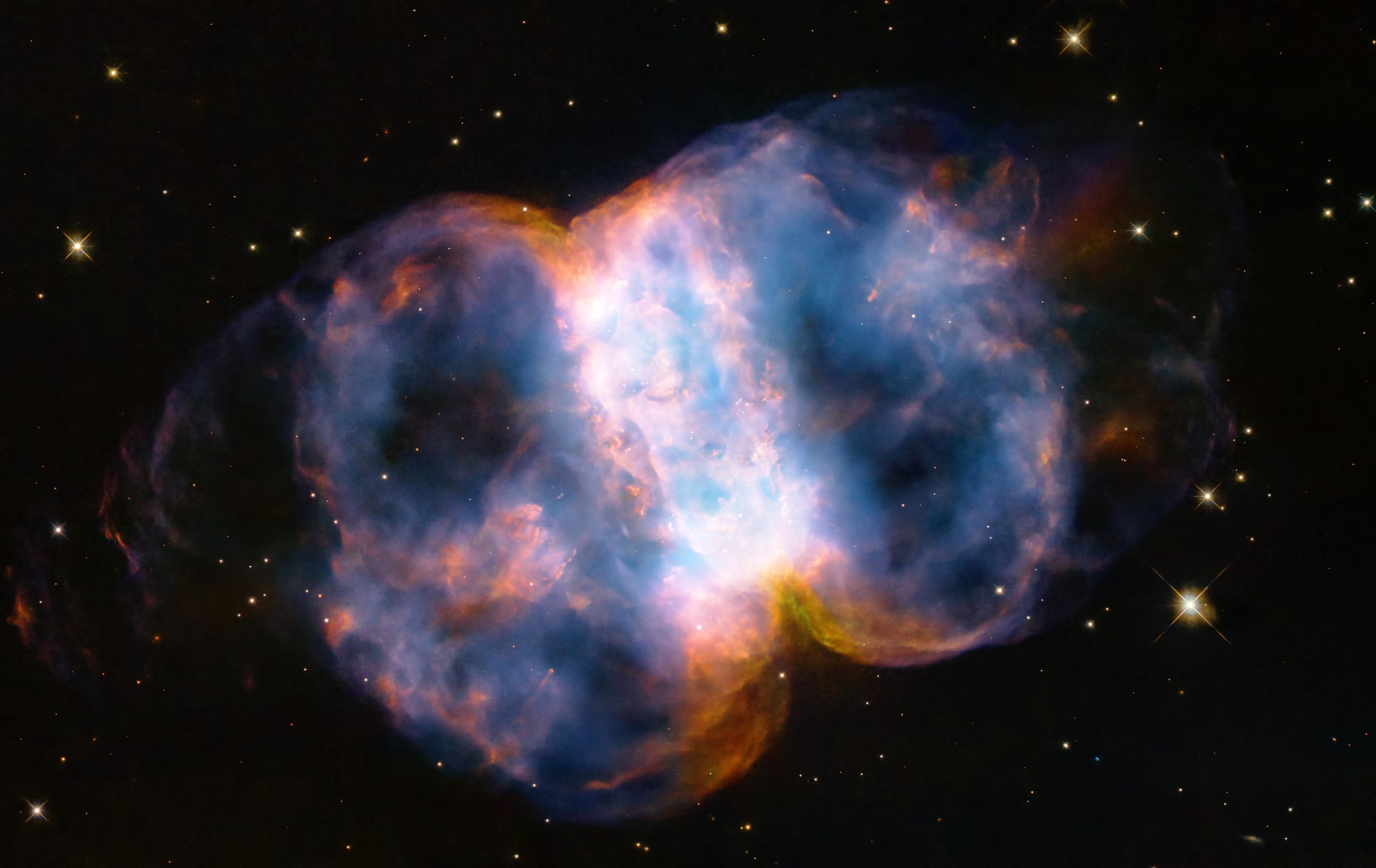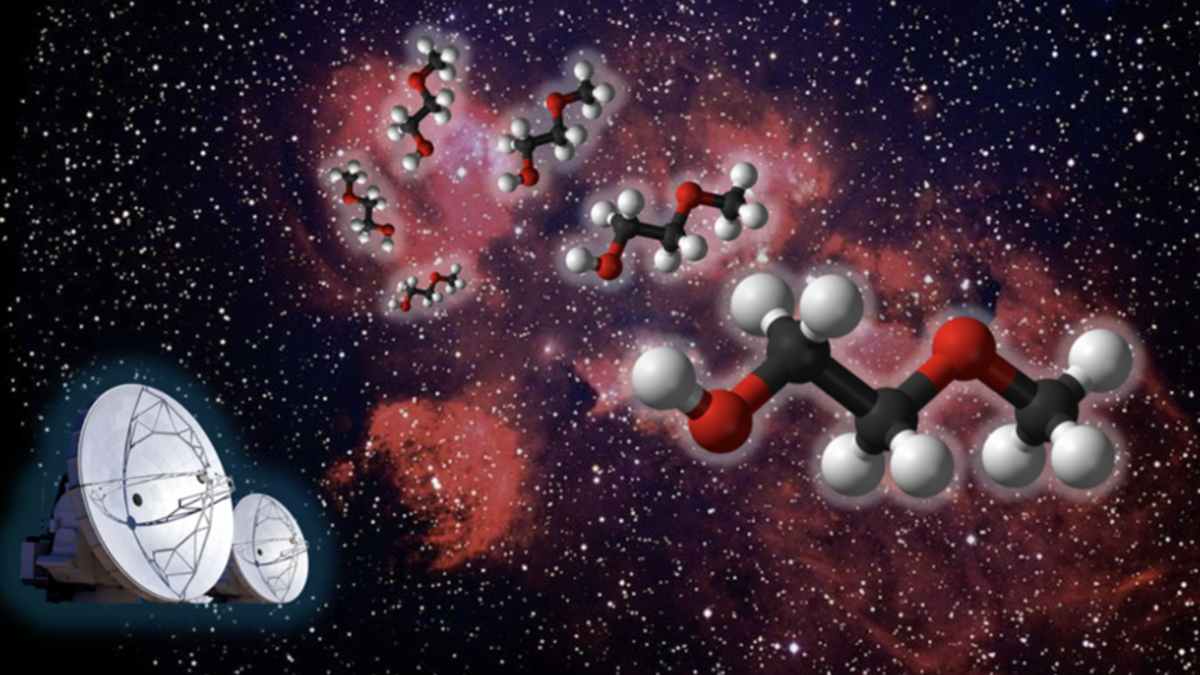이 그림은 행성계의 부서진 시체에서 파편을 끌어당기는 백색 왜성을 보여줍니다. 허블 우주 망원경은 행성의 구성 요소인 광물과 얼음 암석 물질의 혼합물을 드러내는 증발하는 파편의 분광학적 특징을 감지합니다. 그 결과는 진보된 행성계의 폭력적인 성질과 무너져가는 몸체의 구성을 설명하는 데 도움이 됩니다. 출처: NASA, ESA, Joseph Olmsted(STScI)
백색 왜성 표면의 잔해에서 암석과 얼음 물체가 모두 확인되었습니다.
“네 시체를 꺼내라!” 주변에서 일어나는 일의 평행 장면인 고전 영화 “몬티 파이튼과 성배”의 공중 루프[{” attribute=””>white dwarf star in a nearby planetary system. The dead star is “ringing” its own bell, calling out to the “dead” to collect at its footsteps. The white dwarf is all that remains after a Sun-like star has exhausted its nuclear fuel and expelled most of its outer material – decimating objects in the planetary system that orbit it. What’s left is a band of players with unpredictable orbits that – despite protests that they “aren’t dead yet!” – will ultimately be captured by the central star.
How do we know? The bodies consumed by the star leave telltale “fingerprints” – caught by the Hubble Space Telescope and other NASA observatories – on its surface. The spectral evidence shows that the white dwarf is siphoning off both rocky-metallic and icy material – debris from both its system’s inner and outer reaches. Uncovering evidence of icy bodies is intriguing, since it implies that a “water reservoir” might be common on the edges of planetary systems, improving the chances for the emergence of life as we know it.
별의 죽음의 고통은 행성계를 너무 격렬하게 파괴하여 백색 왜성이라고 불리는 죽은 별이 행성계의 내부 및 외부 돌출부에서 파편을 끌어내고 있습니다. 천문학자들이 행성의 구성 요소인 광물과 얼음 같은 암석 물질을 모두 소비하는 백색 왜성을 관찰한 것은 이번이 처음입니다. NASA의 허블 우주 망원경과 다른 NASA 관측소의 보관 데이터는 이 우주 식인 풍습을 진단하는 데 필수적이었습니다. 그 결과는 진보된 행성계의 폭력적인 특성을 설명하는 데 도움이 되며 천문학자들에게 새로 형성된 시스템의 구성에 대해 알려줄 수 있습니다. 출처: NASA의 Goddard 우주 비행 센터; 메인프로듀서: 폴 모리스
죽은 별이 행성계를 찢는 모습을 포착했습니다.
별의 죽음의 고통은 행성계를 너무 격렬하게 파괴하여 백색 왜성이라고 불리는 죽은 별이 행성계의 내부 및 외부 돌출부에서 파편을 끌어내고 있습니다. 천문학자들이 행성의 구성 요소인 광물과 얼음 같은 암석 물질을 모두 소비하는 백색 왜성을 관찰한 것은 이번이 처음입니다.
NASA의 허블 우주 망원경과 다른 NASA 관측소의 보관 데이터는 이 우주 식인 풍습을 진단하는 데 필수적이었습니다. 그 결과는 진보된 행성계의 폭력적인 특성을 설명하는 데 도움이 되며 천문학자들에게 새로 형성된 시스템의 구성에 대해 알려줄 수 있습니다.
그 결과는 가까운 백색 왜성 G238-44의 대기에 의해 포착된 물질의 분석을 기반으로 한다. 백색 왜성은 우리 태양과 같은 별이 핵융합을 통해 외부 층을 제거하고 연료 연소를 중단한 후 남은 것입니다. UCLA(UCLA)의 수석 연구원이자 최근 졸업생인 테드 존슨(Ted Johnson)은 “우리는 이 두 종류의 천체가 동시에 백색 왜성에 축적되는 것을 본 적이 없다”고 말했다. “이 백색 왜성을 연구함으로써 우리는 아직 손상되지 않은 행성계에 대해 더 잘 이해할 수 있기를 희망합니다.”

이 그림은 G238-44 행성계의 파괴를 추적합니다. 작은 백색 왜성이 그 행동의 중심에 있습니다. 매우 희미한 강착 원반은 백색 왜성 위로 떨어지는 너덜너덜한 몸체 조각으로 구성되어 있습니다. 소행성과 나머지 행성체는 별을 둘러싸고 있는 물질의 저장소를 형성합니다. 더 큰 가스 거대 행성은 여전히 시스템에 있을 수 있습니다. 훨씬 더 멀리 떨어진 곳에는 혜성과 같은 얼음 덩어리가 있는데, 이 벨트도 결국에는 죽은 별을 먹여살립니다. 출처: NASA, ESA, Joseph Olmsted(STScI)
이 발견은 또한 작고 얼음이 많은 물체가 우리 태양계의 건조하고 암석이 많은 행성과 충돌하고 “관개”하는 것으로 알려져 있기 때문에 흥미롭습니다. 수십억 년 전에 혜성과 소행성이 지구에 물을 공급하여 우리가 알고 있는 생명체에 필요한 조건을 만든 것으로 믿어집니다. 존슨은 백색 왜성에 비가 내리는 것으로 관찰된 천체의 구성은 얼음 저수지가 행성계에서 흔히 볼 수 있음을 시사한다고 말했다.
UCLA 교수이자 공동 저자인 Benjamin Zuckerman은 “우리가 알고 있는 생명체는 탄소, 질소, 산소와 같은 다양한 원소로 덮인 암석 행성이 필요합니다. “우리가 이 백색 왜성에서 볼 수 있는 풍부한 요소는 암석이 많고 휘발성이 풍부한 본체를 필요로 하는 것으로 보입니다. 수백 개의 백색 왜성에 대한 연구 중에서 발견한 첫 번째 예입니다.”
더비를 무너뜨리다
행성계 진화 이론은 적색 거성과 백색 왜성 단계 사이의 전환을 혼란스러운 과정으로 설명합니다. 별은 빠르게 외층을 잃어가고 있으며 행성의 궤도는 극적으로 변합니다. 소행성과 왜행성과 같은 작은 물체는 거대한 행성에 가까이 다가가 별을 향해 떨어질 수 있습니다. 이 연구는 이 격렬한 혼돈 단계의 실제 규모를 확인하여 백색 왜성 단계가 시작된 후 1억 년 이내에 별이 소행성대와 카이퍼대 같은 지역에서 물질을 동시에 포착하고 소비할 수 있음을 보여줍니다.
이 연구에서 백색 왜성이 잡아먹는 것으로 추정되는 총 질량은 소행성이나 작은 달의 질량보다 크지 않을 수 있습니다. 백색 왜성이 소비하는 물체가 두 개 이상 존재하는지 직접 측정할 수는 없지만, 하나는 소행성만큼 미네랄이 풍부하고 다른 하나는 우리 태양계의 변두리에서 발견되는 것과 유사한 얼음 물체일 가능성이 높습니다. 카이퍼 벨트에서.
천문학자들이 5,000개 이상의 외계행성을 분류했지만 지구는 우리가 내부 구성에 대해 어느 정도 직접적인 지식을 갖고 있는 유일한 행성입니다. 백색 왜성 식인 풍습은 행성을 부수고 별 주위에 처음 형성되었을 때 행성이 무엇으로 만들어졌는지 배울 수 있는 독특한 기회를 제공합니다.
팀은 다른 요소들 중에서 질소, 산소, 마그네슘, 규소 및 철의 존재를 측정했습니다. 매우 많은 양의 철의 발견은 지구와 같은 지구형 행성의 금속 코어가 존재한다는 증거입니다.[{” attribute=””>Venus, Mars, and Mercury. Unexpectedly high nitrogen abundances led them to conclude the presence of icy bodies. “The best fit for our data was a nearly two-to-one mix of Mercury-like material and comet-like material, which is made up of ice and dust,” Johnson said. “Iron metal and nitrogen ice each suggest wildly different conditions of planetary formation. There is no known solar system object with so much of both.”
Death of a Planetary System
When a star like our Sun expands into a bloated red giant late in its life, it will shed mass by puffing off its outer layers. One consequence of this can be the gravitational scattering of small objects like asteroids, comets, and moons by any remaining large planets. Like pinballs in an arcade game, the surviving objects can be thrown into highly eccentric orbits.
“After the red giant phase, the white dwarf star that remains is compact – no larger than Earth. The wayward planets end up getting very close to the star and experience powerful tidal forces that tear them apart, creating a gaseous and dusty disk that eventually falls onto the white dwarf’s surface,” Johnson explained.
The researchers are looking at the ultimate scenario for the Sun’s evolution, 5 billion years from now. Earth might be completely vaporized along with the inner planets. But the orbits of many of the asteroids in the main asteroid belt will be gravitationally perturbed by Jupiter and will eventually fall onto the white dwarf that the remnant Sun will become.
For over two years, the research group at UCLA, the University of California, San Diego, and the Kiel University in Germany, has worked to unravel this mystery by analyzing the elements detected on the white dwarf star cataloged as G238-44. Their analysis includes data from NASA’s retired Far Ultraviolet Spectroscopic Explorer (FUSE), the Keck Observatory’s High Resolution Echelle Spectrometer (HIRES) in Hawaii, and the Hubble Space Telescope’s Cosmic Origins Spectrograph (COS) and Space Telescope Imaging Spectrograph (STIS).
The team’s results were presented at an American Astronomical Society (AAS) press conference on Wednesday, June 15, 2022.
The Hubble Space Telescope is a project of international cooperation between NASA and ESA (European Space Agency). NASA’s Goddard Space Flight Center in Greenbelt, Maryland, manages the telescope. The Space Telescope Science Institute (STScI) in Baltimore, Maryland, conducts Hubble science operations. STScI is operated for NASA by the Association of Universities for Research in Astronomy, in Washington, D.C.

“음악 팬. 매우 겸손한 탐험가. 분석가. 여행 괴짜. 익스트림 TV 전문가. 게이머.”




